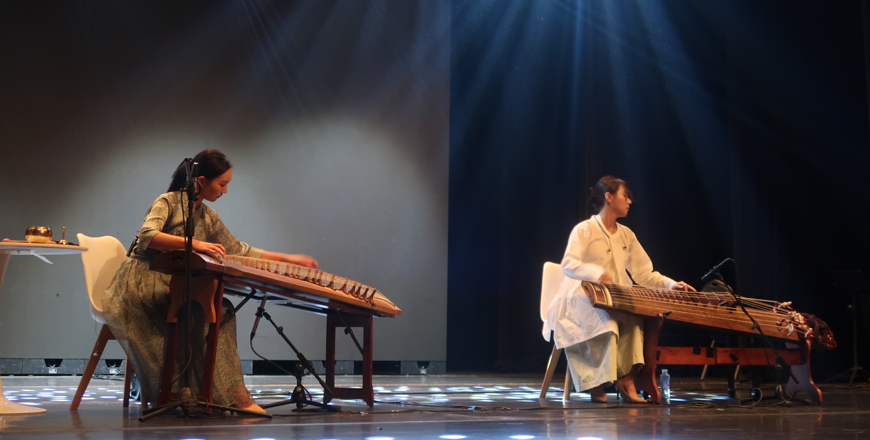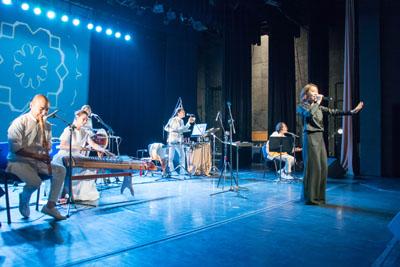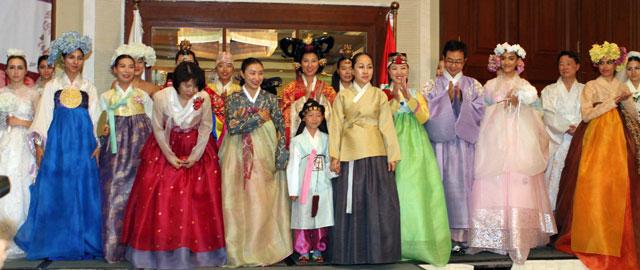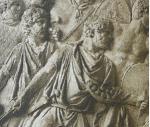You are here
DAL:UM duo brings Korean traditional strings to Amman
By Sophie Constantin - Nov 21,2024 - Last updated at Nov 21,2024

Performers Ha Suyean and Hwang Hyeyoung captivate the audience in a musical journey through Korea’s heritage (Photo by Sophie Constantin)
AMMAN — The Korean Embassy in Jordan concluded its 2024 cultural events calendar with a captivating musical concert by DAL:UM, a Seoul-based duo that redefines Korea’s most renowned traditional string instruments. The performance, held on Wednesday at the Hussein Cultural Centre, showcased the harmonious interplay of the gayageum and the geomungo, two instruments steeped in history.
Performers Ha Suyean (gayageum) and Hwang Hyeyoung (geomungo) offered the audience a musical journey through Korea’s heritage, blending ancient sounds with innovative modern interpretations. While visually similar, the two instruments differ significantly in structure, technique, and tone.
The gayageum is a traditionally 12-string wooden instrument with bright, warm, and soft tone, while the geomungo, traditionally with six strings, offers a deeper, more resonant sound. For this performance, Ha played a 25 strings gayageum, while Hwang used a modernized 10-string geomungo, highlighting the instruments’ evolution over centuries.
Korea has produced music for thousands of years into the modern day. Traditional music produced by Korea includes court music, folk music, poetic songs, and religious music used in shamanistic and Buddhist traditions, as well as the famous modern K-pop.
The gayageum and geomungo are deeply rooted in Korea’s ancient kingdoms. According to the “Samguksagi” (Chronicles of the Three States between the 1st century BC and the 7th century AD), the gayageum was created by King Gasil of Gaya (one of the ancient Kingdoms of Korea). Its name, meaning “strings of Gaya”, reflects its cultural significance across Korea’s Silla, Goryeo, and Joseon dynasties, where it was cherished by both royalty and the public.
The geomungo, on the other hand, was developed by a Goguryeo prime minister and remains prominently depicted in murals from the ancient kingdom. With a range of three octaves, its profound tone made it the favourite instrument of the noble scholars of the Chosun dynasty. Geomungo has the widest range of notes among traditional instruments of Korea, and its name is thought to mean strings of Goguryeo, and it is found commonly in the murals of ancient tombs of Goguryeo.
Creating these instruments requires painstaking craftmanship. The lower part is crafted from sturdy chestnut wood, while the upper soundbox is made from royal foxglove. Twisted silk threads are used for the strings, with the entire process taking up to seven years to ensure the highest quality and sound.
Since forming in 2018, the DAL:UM duo has gained recognition for pushing the boundaries of these ancient instruments. Their innovative reimagining of the gayageum and geomungo – including performances with modern variations such as a 25-string gayageum and a 10-string geomungo – have reshaped the perception of traditional Korean music. By blending history with modernity, the duo preserves the instruments’ legacies while exploring new possibilities.
The concert marked the finale of a yearlong series of cultural programmes organised by the Korean Embassy in Jordan, aimed at strengthening ties and sharing Korea’s rich heritage with Jordanian audiences.
Related Articles
AMMAN — The 2015 Korean Cultural Week in Amman concluded its festivities on Wednesday at Al Hussein Cultural Centre in Ras Al Ain with a per
AMMAN — The oud is said to be one of the most important historical and modern instruments in Arabic music, Amman-born composer and oud playe
Jordanians and Koreans held a joint fashion show on Friday, showcasing Jordanian, Palestinian and Korean traditional costumes in a bid to foster cultural exchange and raise awareness of their traditions, ancient heritage and values.














